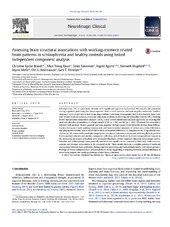| dc.contributor.author | Brandt, Christine Lycke | |
| dc.contributor.author | Doan, Nhat Trung | |
| dc.contributor.author | Tønnesen, Siren | |
| dc.contributor.author | Agartz, Ingrid | |
| dc.contributor.author | Hugdahl, Kenneth | |
| dc.contributor.author | Melle, Ingrid | |
| dc.contributor.author | Andreassen, Ole Andreas | |
| dc.contributor.author | Westlye, Lars Tjelta | |
| dc.date.accessioned | 2016-02-08T14:16:55Z | |
| dc.date.available | 2016-02-08T14:16:55Z | |
| dc.date.issued | 2015 | |
| dc.Published | NeuroImage: Clinical 2015, 9:253-263 | eng |
| dc.identifier.issn | 2213-1582 | |
| dc.identifier.uri | https://hdl.handle.net/1956/11050 | |
| dc.description.abstract | Schizophrenia (SZ) is a psychotic disorder with significant cognitive dysfunction. Abnormal brain activation during cognitive processing has been reported, both in task-positive and task-negative networks. Further, structural cortical and subcortical brain abnormalities have been documented, but little is known about how task-related brain activation is associated with brain anatomy in SZ compared to healthy controls (HC). Utilizing linked independent component analysis (LICA), a data-driven multimodal analysis approach, we investigated structure–function associations in a large sample of SZ (n = 96) and HC (n = 142). We tested for associations between task-positive (fronto-parietal) and task-negative (default-mode) brain networks derived from fMRI activation during an n-back working memory task, and brain structural measures of surface area, cortical thickness, and gray matter volume, and to what extent these associations differed in SZ compared to HC. A significant association (p < .05, corrected for multiple comparisons) was found between a component reflecting the task-positive fronto-parietal network and another component reflecting cortical thickness in fronto-temporal brain regions in SZ, indicating increased activation with increased thickness. Other structure–function associations across, between and within groups were generally moderate and significant at a nominal p-level only, with more numerous and stronger associations in SZ compared to HC. These results indicate a complex pattern of moderate associations between brain activation during cognitive processing and brain morphometry, and extend previous findings of fronto-temporal brain abnormalities in SZ by suggesting a coupling between cortical thickness of these brain regions and working memory-related brain activation. | en_US |
| dc.language.iso | eng | eng |
| dc.publisher | Elsevier | eng |
| dc.rights | Attribution CC BY-NC-ND | eng |
| dc.rights.uri | http://creativecommons.org/licenses/by-nc-nd/4.0/ | eng |
| dc.subject | Schizophrenia | eng |
| dc.subject | Structure–function | eng |
| dc.subject | Fronto-parietal | eng |
| dc.subject | Default-mode | eng |
| dc.subject | Functional magnetic resonance imaging | eng |
| dc.subject | Linked independent component analysis | eng |
| dc.title | Assessing brain structural associations with working-memory related brain patterns in schizophrenia and healthy controls using linked independent component analysis | eng |
| dc.type | Peer reviewed | |
| dc.type | Journal article | |
| dc.date.updated | 2015-09-15T11:17:55Z | |
| dc.description.version | publishedVersion | |
| dc.rights.holder | Copyright 2015 The Authors | eng |
| dc.identifier.cristin | 1258810 | |
| dc.relation.project | Norges forskningsråd: 204966 | |

